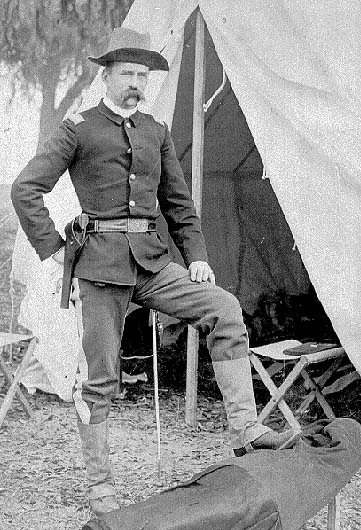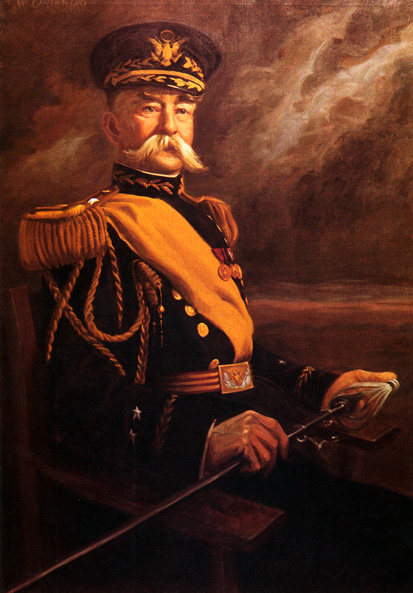William Wallace Wotherspoon was born in Washington, D.C., on 16 November 1850; was educated in private schools.
He served aboard ship as a mate in the United States Navy, 1870-1873; was commissioned a Second Lieutenant,United States Army, and assigned to the 12th Infantry in October 1873. He served in the West during the Indian wars as a troop officer and quartermaster, 1874-1881. He then served with the 12th in northern New York, 1881-1887. He married Mary C. Adams in 1887, and was on sick leave 1888-1889.
He superintended the enlargement of the Soldiers’ Home in Washington, 1889-1890, then served at Fort Sully and at Mount Vernon Barracks, where he trained a company of Apache prisoners, 1890-1894. He was promoted to Captain, 1893 and was then aide to General Oliver O. Howard, commander of the Department of the East, 1894.
He was then professor of military science and tactics at Rhode Island College, 1894-1898 and was on recruiting duty at Fort McPherson and organized the 3d Battalion, 12th Infantry, 1898, serving in the Philippines against insurgents and as collector of customs at Iloilo, 1899-1901.
He was promoted to Major and transferred to the 30th Infantry, 1901, then commanded the 2d Battalion, 6th Infantry, at Fort Leavenworth, Kansas, and then taught at the General Staff College, 1902-1904.
He was promoted to Lieutenant Colonel and assigned to the 14th Infantry in 1904. He was then transferred to the 19th Infantry and graduated from the Army War College in 1905. He was director of the Army War College, 1904-1906; was Chief of Staff of the Army of Cuban Pacification in 1906-1907. He was acting president of the Army War College and Chief of the Third Division, General Staff, 1907.
Wotherspoon was promoted to Brigadier General in October 1907 and was president of the Army War College, 1907-1909 and 1910-1912, and largely instrumental in transforming it from an adjunct of the General Staff to an autonomous educational institution. He was Assistant to the Chief of Staff, 1901-1910 and 1912-1914. He was promoted to Major General in May 1912, serving as commander of the Department of the Gulf until September; was Chief of Staff of the United States Army 21 April-15 November 1914 where he called attention to shortages of officers and noncommissioned officers for Army missions, emphasized the need to reevaluate coast defenses to meet heavier-gunned battleships, saw establishment of an aviation section in the Signal Corps and the completion of the Panama Canal.
The General retired from active service in November 1914 and then served as Superintendent of Public Works for the state of New York, 1915-1920. The General died in Washington, D.C. on 21 October 1921 and was buried withfull military honors in Arlington National Cemetery.
WOTHERSPOON, WILLIAM W
MAJ GEN USA RET
- DATE OF DEATH: 10/21/1921
- BURIED AT: SECTION 3 SITE 1949
ARLINGTON NATIONAL CEMETERY
WOTHERSPOON, MARY A W/O WILLIAM WALLACE
- DATE OF BIRTH: 12/04/1865
- DATE OF DEATH: 12/17/1953
- BURIED AT: SECTION 3 SITE 1949
ARLINGTON NATIONAL CEMETERY - WIFE OF WW WOTHERSPOON
MAJOR GENERAL CHIEF OF STAFF USA
Michael Robert Patterson was born in Arlington and is the son of a former officer of the US Army. So it was no wonder that sooner or later his interests drew him to American history and especially to American military history. Many of his articles can be found on renowned portals like the New York Times, Washingtonpost or Wikipedia.
Reviewed by: Michael Howard


